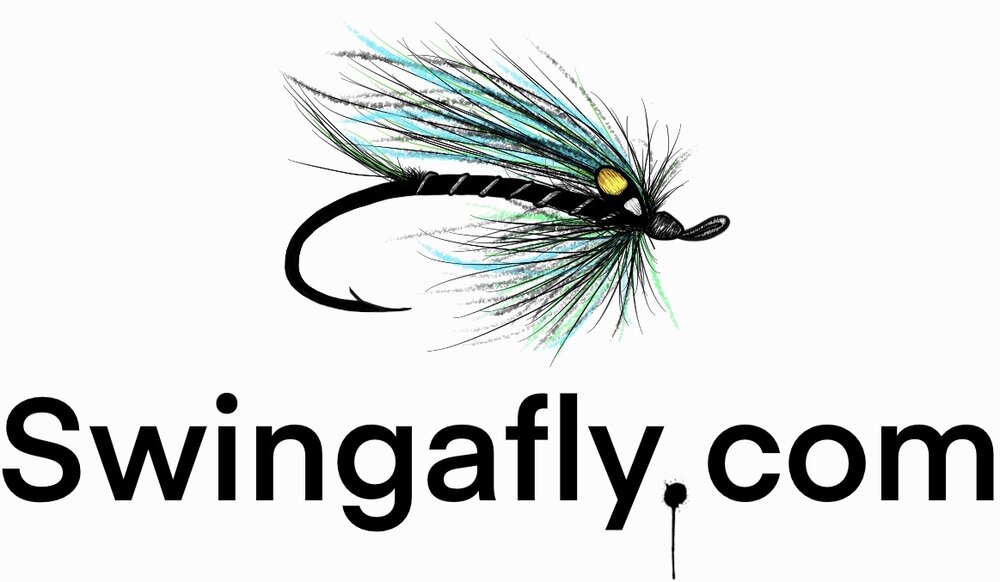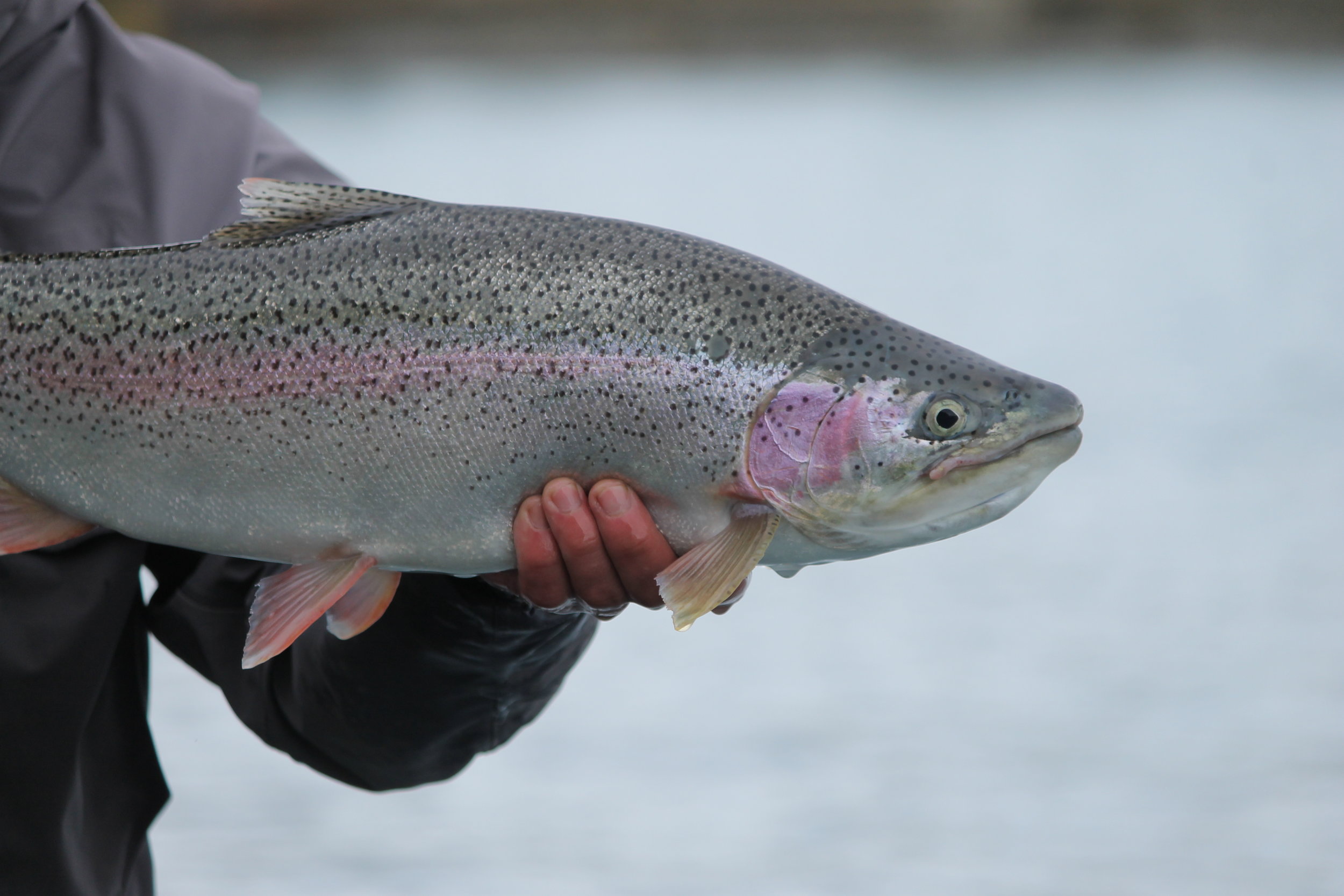Rachel was kind enough to create this fish calendar for me to put on the website. I figured I would throw it on the blog as well. Cheers!
Plump Kenai River rainbow
Flies for the Kenai River - Part 3
For part three of flies for the Kenai River we are gonna talk rainbows. I’m going to include Dolly Varden on this topic as you would fish for them the same way. I figured the easiest way to go about this is to go through each seasons. This is a very basic overview of how to approach the Kenai. With 70 plus miles of river, theres too many flies and methods to discuss in just one blog post. That being said, I’m going to keep it pretty basic. Let’s get started.
Rainbow Trout / Dolly Varden
First, let’s talk spring. On the Kenai river, trout fishing is closed from May 1st - June 11th from Skilak lake and above. They close the upper sections of the river to allow for the rainbows to complete their spawn. Smart move. That being said, you can legally fish trout below Skilak Lake during that time. Lets start there. This middle and lower section of the river holds arguably more big fish than the upper stretches. Their diets are different. The majority of the pinks that spawn (every other year) do so on the middle and lower stretches. Although a good portion of Sockeye spawn on the upper, there are still plenty of Sockeye eggs found on the middle and lower stretches. That, combined with a healthy number of fish carcasses lead to some very obese trout. Early spring flies on these stretches would include old washed out flesh and eggs. Float the middle in early May and you will see hoards of old rotten flesh floating down the river. Large flesh flies composed of bunny strip under an indicator work well. The dirtier the flesh the better. Pale and creamy colored zonkers will catch fish. I even like to take a razor blade to a zonker strip to thin it out, as the old flesh looks very “whispy” in the water. Remember, its been locked up in ice all winter. As the thaw comes, so does the old flesh. Smaller flesh flies have their place too if a bigger meal doesn’t get the job done. Remember, unlike the “fresh” flesh, old flesh is ragged looking, so make sure to tie or buy something rotten. Same goes for your beads. Old, washed out eggs will catch fish. I prefer to use an 8mm bead, but I know guys that will catch just as many fish on a 10mm bead. Again, think old and pale. If eggs and flesh isn’t your thing, swing or dead drift a leech or sculpin, another proven tactic for early spring trout.
Now lets move into the summer. Your flesh flies will now change to “fresh” flesh as the salmon filleting has begun. Same goes for your beads. As the sockeye fishermen aim for limits everyday, the trout are on standby, waiting for the next easy meal to float down river. If fishing flesh and beads, concentrate on the areas below sockeye fisherman, or flesh traps. Flesh traps are areas where filleted remains will float down and get trapped, creating popular feeding zones for the trout all summer. Most of the flesh and bead fishing is the same throughout the entire river. Finding the right water to fish is important. Think outside to box and get into the spots where you know the easy meat is at. The Kings will start to spawn towards the end of July. Triggering the first stage of the bead bite. 10mm - 14mm beads are your best bet. Fresh eggs to washed out eggs. Fish em deep as Kings will spawn in the gut of the river. Long leaders and some lead will assist. If fishing bugs is your thing, move on up to the upper stretches of the Kenai and have yourself a blast. Caddis, stoneflies and mayflies all play a pivotal role in an upper river trout’s diet. I’ve even had a fair amount of success fishing large midges just below Kenai lake. As always, a swung leech or sculpin will catch fish as well. Trout can be finicky during the dog days of summer. With constant sunlight, I find that they will slide into a little bit deeper water for refuge. Adapt accordingly.
Moving on. Once the first Sockeye drops an egg in August, all bets are off. The dinner bell has rung. The trout will now be keying in on fresh sockeye eggs. 8mm and 6mm fresh Sockeye beads are your ticket. An actual Sockeye Salmon egg is in fact 7mm, but I have yet to find a bead manufacturer that sells a 7mm bead. Regardless, a bright fresh egg in the two sizes I mentioned will catch fish. As the days go by, pay attention to the spawning activity. If you don’t see much activity, switch to a not so fresh egg. A little bit of research regarding the stages of a salmon egg will go a long way. If you are fishing the Kenai River during a pink year, 8mm - 10mm beads will work. Again, fresh to washed out depending on the spawning activity. The flesh bite is still on as the trout are now moving into full blown feed mode. So if the beads aren’t producing, some micro flesh or a big honker might do the trick. I haven’t done much streamer fishing during early fall, but I’m sure a leech or sculpin would catch a few fish.
Moving into post salmon spawn, washed out eggs and flesh will be on the menu. The time for swinging leeches and sculpin is also present. I personally prefer this time of year the most. The trout are still insanely hungry, and with food become a little more scarce, it becomes a bit easier to fool the much larger rainbows. Again, a great time to swing for large bows. Blacks and olives with a little flash are my go to’s. I will typically swing a 3-5 inch leech or sculpin, weighted and unweighted depending on the water i’m fishing. Make sure to bring plenty of sink tip options. I always keep tips ranging from T-8 - T-14 in a multitude of lengths. Depending on where you are fishing, having a variety of tips will keep you in the zone on each run you decide to fish. This type of fishing will continue all through the winter and has become quite popular on the Kenai.
As the fall passes and we transcend into the winter months, the fishing can still be fantastic. Winter fishing on the Kenai River can be quite lonely on certain days. limited sunshine and daylight, your window for opportunity can be short. Swinging and nymphing are still productive. Trout will winter over in certain areas of the Kenai. Lakes, confluences, deep slow pools, etc. The key in the winter is to find them. Near the headwaters of the Kenai, large midges will produce fish even in the coldest of winter days. Big stonefly patterns with some rubber legs for added wiggle are effective as well. Fish them deep. So gather up some bugs, flesh and eggs, some leeches, and you’re all set for you winter trout adventure.
So there you have it. A very short, basic introduction to must have trout flies for the Kenai River. I hope this helped a little bit in your research. We run trout trips all summer long on the Kenai, come fish with us and I would be happy to share what I know during a day on the river. Tight lines!
My girlfriend Rachel Lubarski with her first King on a fly. Caught on the Kenai River.
Flies for the Kenai River - Part 2
So for part two of flies for the Kenai River let’s talk Kings. The King of the river does nothing short of living up to it’s name. They are tough bastards and will most definitely test your patience and skill level.
King Salmon
Ahhh Kings. I love them but hate them at the same time. Getting one on the swing either on the Kenai or Kasilof is nothing short of epic. Ten pounders, sixty pounders, they all rock. Assuming you aren’t flipping for them, lets talk flies and set-ups.
First off, a switch rod or spey rod is almost a must for the Kenai or Kasilof as you will want to cove as much water as possible. That extra distance with the two handed rods can make or break your success. Accompanied with a lengthy section of T-14, which will vary depending on time of year and flows, you are ready to get started. Onto the flies…
Maybe its because I first started swinging flies in Michigan rivers that I’ve grown partial to weighted flies. First and foremost I want my fly to get down. Even if that means sacrificing a elegantly placed cast. My cast won’t be pretty but I know my fly is where it needs to be, down and in the zone. All while casting down and across. Hitting bottom every once in awhile makes me feel like i’m right where I need to be. Now, when we go out swinging for Kings, I don't even stop to take a piss. Its cast, cast, cast, step, repeat. Non stop. I’m sure guys can relate. If you want it bad enough you know you need that fly in the water. I got soooo tired of chucking heavily weighted flies. To the point of 6 hours of non stop casting I was losing more and more distance on my cast as time went on. Your casting will go from ugly to frustrating real quick doing that all day. So, I started to switch things up. Shorter leader off of my sink tip, and an unweighted fly. Many advantages to this. First off, the ability to cast all day at greater distances and less effort. Second, my flies now have more wiggle and fish appeal without the lead eyes. Lastly, I can compensate less weight by a straight across cast, giving my fly and tip a little more time to get down where it needs to be.
So weighted, unweighted, what type of flies are we talking? If you are fishing the turquoise waters of the Kasilof of Kenai, I wouldn’t leave home without a chartreuse fly. Chartreuse rules the color universe on these two particular rivers. You can definitely pair with a black, silver, or steelhead blue. Every one of my king flies have chartreuse in them. Get creative. Super flashy, not so flashy, silver and chartreuse, blue and chartreuse, try them all. I will mainly tie intruders with big broad shoulders on them to create a large profile. 50mm shanks up to 75mm shanks. Think length with a broad profile and plenty of flash fo dat ass. Marabou, ostrich, synthetics, pick your poison, as long as it has a good profile in the water. Leeches and dirty ho’s work well too but are heavy to cast. It’s hard to beat the action of a big bunny strip in the water but i’ll sacrifice that action for ease of casting. Not to mention a well built intruder will kick off some good swim action in the water too.
So there you have it, a little insight into fly selection for Kings on the Kenai and Kasilof rivers. Just remember, a large and broad profile in the water with some flash and good kicking action will get it done. Think chartreuse. That combined with some serious patience and you’re all set to get after ‘em. Good luck, you will need it with these fish.



